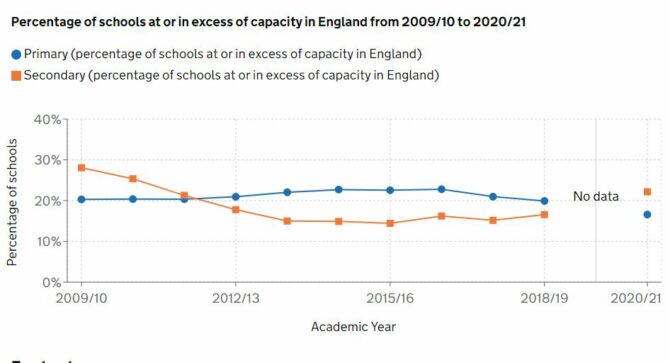Over one in five secondary schools in England are now full or over capacity, new government data has revealed.
But the proportion of primary schools that are full is decreasing, as a result of a population bulge moving between the two phases.
The Department for Education today published its latest school capacity data, based on survey responses from local authorities as of May 2021.
The data shows 750 secondary schools, around 22 per cent, were at or over capacity in 2020-21, up from 560, or 17 per cent in 2018-19, a rise of 34 per cent.
School capacity data was not collected in 2020, to reduce the burden on schools during the pandemic.
The DfE said the increase “corresponds to the larger cohort moving into the secondary phase”.
Of the 750 schools, 610 were over-capacity by 10 or more pupils, while 130 exceeded capacity by fewer than 10.

Despite the increase in the number of full or over-subscribed secondary schools, the level is still lower than it was in 2010, when 930 were at or over capacity.
Around 56,000 secondary pupils are now in places that exceed their school’s capacity, up from 50,000 in 2019.
Places are being filled by children reaching secondary age “after the high birth rate from 2008 to 2012”.
The percentage of secondary schools with one or more unfilled places fell to 78 per cent.
Strain on primary school capacity eases
At the same time, the percentage of primary schools that are full or oversubscribed decreased from 3,340 (20 per cent) in 2019 to 2,790 (17 per cent) in 2021.
In primary schools there were 21,000 pupils in places that exceeded their schools’ capacity, and 83 per cent of primary schools had one or more unfilled places – the highest level in over a decade.
Local authority forecasts suggest the demand for primary school places will peak this year and then taper off.
However, they expect demand for secondary school places will rise until 2025-26 before levelling off.
“This is due to the increase previously seen in primary pupil numbers continuing through the secondary phase”, the government said.
The DfE said there was a “notable decrease” in 2021 primary enrolment due to the pandemic and the UK’s exit from the EU. This is “expected to be temporary”.








Your thoughts